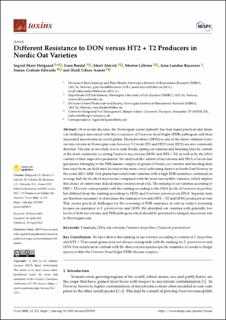| dc.contributor.author | Hofgaard, Ingerd Skow | |
| dc.contributor.author | Brodal, Guro | |
| dc.contributor.author | Almvik, Marit | |
| dc.contributor.author | Lillemo, Morten | |
| dc.contributor.author | Russenes, Aina Lundon | |
| dc.contributor.author | Edwards, Simon Graham | |
| dc.contributor.author | Aamot, Heidi Udnes | |
| dc.date.accessioned | 2022-10-14T07:46:20Z | |
| dc.date.available | 2022-10-14T07:46:20Z | |
| dc.date.created | 2022-04-28T19:57:38Z | |
| dc.date.issued | 2022-04-28 | |
| dc.identifier.citation | Toxins. 2022, 14 (5), 1-22. | en_US |
| dc.identifier.issn | 2072-6651 | |
| dc.identifier.uri | https://hdl.handle.net/11250/3026073 | |
| dc.description.abstract | Over recent decades, the Norwegian cereal industry has had major practical and financial challenges associated with the occurrence of Fusarium head blight (FHB) pathogens and their associated mycotoxins in cereal grains. Deoxynivalenol (DON) is one of the most common Fusarium-mycotoxins in Norwegian oats, however T-2 toxin (T2) and HT-2 toxin (HT2) are also commonly detected. The aim of our study was to rank Nordic spring oat varieties and breeding lines by content of the most commonly occurring Fusarium mycotoxins (DON and HT2 + T2) as well as by the DNA content of their respective producers. We analyzed the content of mycotoxins and DNA of seven fungal species belonging to the FHB disease complex in grains of Nordic oat varieties and breeding lines harvested from oat field trials located in the main cereal cultivating district in South-East Norway in the years 2011–2020. Oat grains harvested from varieties with a high FHB resistance contained on average half the levels of mycotoxins compared with the most susceptible varieties, which implies that choice of variety may indeed impact on mycotoxin risk. The ranking of oat varieties according to HT2 + T2 levels corresponded with the ranking according to the DNA levels of Fusarium langsethiae, but differed from the ranking according to DON and Fusarium graminearum DNA. Separate tests are therefore necessary to determine the resistance towards HT2 + T2 and DON producers in oats. This creates practical challenges for the screening of FHB resistance in oats as today’s screening focuses on resistance to F. graminearum and DON. We identified oat varieties with generally low levels of both mycotoxins and FHB pathogens which should be preferred to mitigate mycotoxin risk in Norwegian oats. | en_US |
| dc.language.iso | eng | en_US |
| dc.publisher | MDPI | en_US |
| dc.rights | Navngivelse 4.0 Internasjonal | * |
| dc.rights.uri | http://creativecommons.org/licenses/by/4.0/deed.no | * |
| dc.title | Different Resistance to DON versus HT2 + T2 Producers in Nordic Oat Varieties | en_US |
| dc.title.alternative | Different Resistance to DON versus HT2 + T2 Producers in Nordic Oat Varieties | en_US |
| dc.type | Peer reviewed | en_US |
| dc.type | Journal article | en_US |
| dc.description.version | publishedVersion | en_US |
| dc.rights.holder | © 2022 by the authors | en_US |
| dc.source.pagenumber | 1-22 | en_US |
| dc.source.volume | 14 | en_US |
| dc.source.journal | Toxins | en_US |
| dc.source.issue | 5 | en_US |
| dc.identifier.doi | 10.3390/toxins14050313 | |
| dc.identifier.cristin | 2019942 | |
| dc.relation.project | Norges forskningsråd: 254751 | en_US |
| dc.source.articlenumber | 313 | en_US |
| cristin.ispublished | true | |
| cristin.fulltext | original | |
| cristin.qualitycode | 1 | |

